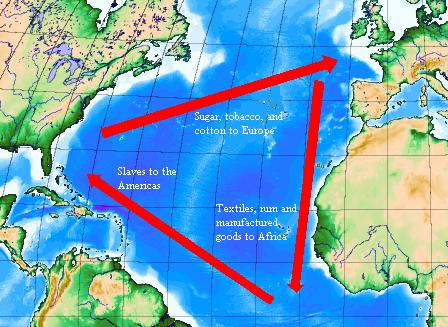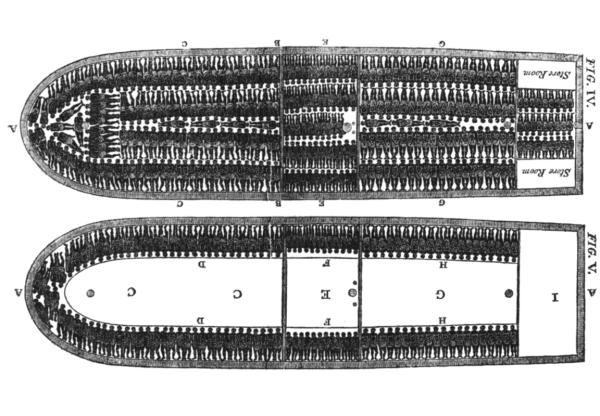
Learning about the History of the United States of America is an important part of one's education in order to learn how civilizations are built, learn about past mistakes and get a grasp of how much we have evolved. The triangular trade is known as a type of trade between three separate ports that serves to balance any imbalances produced between each of these three regions. The Atlantic Triangular Trade, for instance carried slaves, crops and manufactured goods from West Africa, America and the European colonizing countries.
Although this may seem confusing to understand, at oneHOWTO we want to explain the History of the Atlantic Triangular Trade so you can understand it to perfection and learn everything there is to know about this time in history.
What is a triangular trade?
As mentioned above, a triangular trade is the name given to a goods trade that involves three separate points. Thus, each of these three points will export-import their goods with others coming from one of the other two points.
For example:
- Point A has grain and exports it to B.
- Point B imports grain and exports sugar to point C.
- Point C imports sugar and exports timber to point A
And so on... thus creating a triangular trade.
During history, these routes were highly influenced by the winds and currents of the sea, due to the fact that ships moved through sails. The most well-known triangular trades are:
- The Atlantic triangular slave trade
- The sugar triangle
What is the Atlantic Triangular trade
The Atlantic triangular trade was the three sided route that traded goods between England, Africa and the Americas. These three journeys all involved a ship full of cargo that would gain large profits when arriving to their next point of the route. The route is known as a trade route as goods from one point were exchanged with other goods from the destination of the ship.
Thus, the Atlantic Triangular trade exchanged raw materials such as sugar, tobacco, rice or cotton in England in exchange form manufactured goods such as guns, beads or cloths, which in turn were exchanged in Africa for slaves, that were then exchanged for the aforementioned in America.
Keep on reading for an in-depth historical explanation of the Atlantic triangular slave trade.
When did the Atlantic triangular trade start?
The Atlantic triangular slave trade started in the late 16th century and was conceived by European colonists as a cycle of import-export to maintain the wealth of the European empire. One of the major resources that were lacking in the New World was work force, as indigenous Americans had proven to be unreliable and were affected by diseases brought by the Europeans. This is why African people were trusted to be hard workers, were used to agricultural activities and were resistant to many tropical diseases. Thus, the British empire exported manufactured goods that would serve the people in Africa such as ironware, guns, drinks and cloths. These goods would be traded in Africa by slaves (men, women and children). These slaves were sold in the West Indies (the Caribbean) and sold to the highest bidder so they could purchase New World goods they could trade back in Europe such as tobacco, sugar, cotton, coffee and other raw resources back to Europe.
Slave trade to actually began in the 15th century, when the Portuguese and parts of Spain traded slaves to their American colonies. This practice became known among British sailors once the Treaty of Utrecht in 1713 gave the British the right to sell slaves in the Spanish Empire[1]. To gain more benefit, the British conceived the route as a three-way journey to maximize their profit, thus creating what is known as the Atlantic triangular slave trade.
The trade ended in 1776 in all 13 British colonies due to the American Revolutionary war, which ended with slavery in 1808, it still continued in the Caribbean until the 1800s.
Keep on reading if you want to know more about the three parts of the triangular trade.

What are the three parts of the triangular trade?
Let's take a closer look at what happened during each leg of the Atlantic triangular trade. Take into account that the triangular trade does not necessarily refer to the journey, but rather the economic trade system used, as many ships did not complete the three-way journey when trading and used other routes, even though they used this triangular trade system.
The first leg of the triangular trade
Goods such as copper, trinkets, slave beads, guns, ammunition, cloth and other ironware were put into slave ships in different British ports, the most important being London, Bristol and Liverpool. Thus, the first journey began across the Atlantic Ocean towards West Africa, where these goods were traded and sold. Many are the studies that have proven that the guns sold in Africa helped boost the enslavement of African people by 50%[2], which was mainly perpetrated by slave traders and African chiefs.
As mentioned above, there is another pattern that developed at the same time. This one began in New England, notably Rhode Island, where ships were filled with New World manufacturad goods such as rum to export to the African Gold Coast.
The second leg of the triangular trade
Known as the middle passage, this was known to be the most lucrative journey out of the Atlantic triangular trade. Slaves from many West African and Central African areas, most notably Senegambia and the Winward and Gold coast, but also other areas such as Bight of Benin and Biafra and Upper Guinea. Men, women and children were put into slave ships to travel across the Atlantic. During this trip, many died due to diseases caught in the holds they were living in during their five to twelve week journey or died of malnutrition. It is also known that slave captains did not fill their ship in one stop, so they were typically collecting slaves along the coast for 3 to 4 months before actually beginning the second leg of the journey. You can learn more about the conditions of the slaves during the middle passage in the next section.
These slaves were then sold to the highest bidder in West Indian colonies, Brazil, the Spanish Empire and New England to work on plantations or mines.
The third leg of the triangular trade
The ships arriving at their New World destination were then loaded with all American colony goods that would then be exported to either Europe or New England (in the case of raw goods) or back to Africa (in the case of manufactured goods). The most traded commodities were tobacco, coffee, sugar, molasses, hemp and other local crops. Some slave ships had difficulties transporting some crops back to Europe, which is why the leg back to the Old World was commonly made by other type of trade ships that did this route back and forth.

Triangular trade middle passage
What is known as middle passage is the stage of the triangular trade route in which the African slaves where shipped across the Atlantic to be sold as slaves to work the New World's land. Many are the testimonies in the shape of letters, memoirs, logbooks and diaries that have resisted the passage of time to remind us of the conditions in which Africans lived this long journey to the Americas.
African kings and merchants cooperated with traders in order to capture African people in exchange for a small percentage of the trade. People from the Wolof, Mendinka, Fula, Mende or Bassa ethnic groups (to name just a few), were sold and forcefully put into the slave ships.
During this three to four month trip, families were separated in order to mix different nationalities to avoid rebellion, and many of the enslaved people were chained and placed in rows, lying on the floor or shelves inside each of the ships' hulls, with approximately 600 African people travelling on each slave ship. The shelves stacked were so lo that it was frequently impossible to even stand up. Death on these boats was pretty high in percentage, with around 13% of the people of the ship dying of diseases (such as curvy, smallpox or measles) or malnutrition,sometimes as a mean of resistance and suicide. The conditions of slaves during the middle passage were slightly improved by the Dolben Act in 1788 to reduce the number of people on this boat, although their conditions were still harsh, with around 6x1 feet of space given per person.
Once the ships arrived to their American destination, they were then commonly sold to the highest bidder in what was known as slave auctions. They then worked for nothing at all in plantations, even though many were the people who resisted through revolution, silent or personal resistance and suicide.

Myths about the Atlantic Slave trade
The Atlantic slave trade has been commonly taught in History lessons, although there are some facts and myths that are erroneous or not explained properly. At oneHOWTO we'd like to clear some of the most common:
- It is commonly said that slaves came from West Africa. As explained above, slaves came from different areas. In fact, 50% of them came from central Africa[3].
- Most of the slave trade did not take place in the United States but in the West Indies and South America.
- Although the British Empire took great part in the abolition of the slave trade, we must not forget that they were also accountable for the enslavement of 2.5 million Africans.
- Slavery in Africa already existed before the Atlantic triangular slave trade, with several routes that took enslaved Africans to Europe through the Islamic-run or the trans-Saharan routes. In fact, slavery, in different forms, was a traditional part of African society.
- Although it is though that slaves were captured through kidnapping mostly, it was mainly through wars that people were captured and sold, although there was also cases of kidnapping.
If you want to read similar articles to The Atlantic Triangular Trade: Everything you Need to Know, we recommend you visit our Culture & Society category.
- http://www.brown.edu/Research/Slavery_Justice/documents/SlaveryAndJustice.pdf